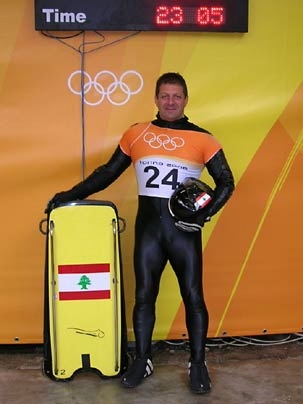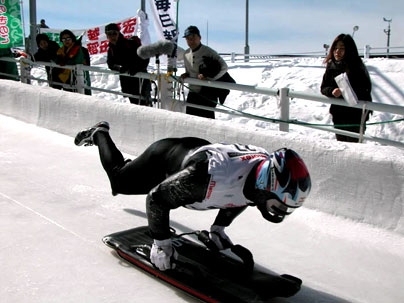MIT alumnus Patrick Antaki '84, a self-employed engineer and entrepreneur living in Texas, is not your typical Olympian. He's never even been much of an athlete, except for some recreational rugby. So how did he end up competing in the Winter Olympics in Torino? He decided to make it happen.
Antaki saw televised coverage of the sled racing sport called skeleton four years ago during the Salt Lake City Olympics, when the sport reappeared after a 54-year hiatus. He'd never had visions of Olympic glory, but Antaki was looking for something different to do. Different turned out to be a sport involving one person on a sled careening down a slick bobsled/luge track at speeds up to 80 mph. There are no brakes, and subtle weight shifts serve for steering.
Some 12 international competitions and nearly 500 runs later, Antaki secured a coveted spot at the Torino Games representing his birth country of Lebanon. He's the first nonskier to represent the Middle Eastern nation in the games and joined two skiers to form the 2006 team.
How did he do it? "Nothing was for sure, of course, but I did my homework, read everything I could about the sport, talked to a bunch of people, and actually tried it. And even though I was really terrible at it for the first year, I had a pretty good idea of what it would take to get up to the level where I could get into the Olympics," Antaki said. "The message is simple: If you're smart, and you study, even though this is an athletic thing, using your brain actually does help."
Antaki qualified for the Olympics in January at the Challenge Cup in Germany, securing the last of eight spots in the level of worldwide competition one tier below the World Cup circuit. He beat out 21 other competitors for the slot.
The Olympic competition played out according to Antaki's expectations, although he was slightly unnerved at the media spectacle. "It's the first time I actually was in the same race with the world's best in the sport," he said. "My goal was just to get there and to finish and that was it, fully expecting to be last." He did come in last, finishing eight and a half seconds behind the gold medal winner. But that was encouraging enough for Antaki, who has set his sights on Vancouver in 2010.
The trick to skeleton, Antaki said, is negotiating the many variables: a slider's weight and speed, the weather, ice quality, how well the sled's runners are polished, how one enters turns.
He received contradictory advice from fellow racers and discovered, "People don't really know what works. It's just a lot of trial and error."
So, Antaki puts his MIT degree in electrical engineering to good use. He souped up his training sled with accelerometers, gyroscopes and a camera to record data and compare runs to discern useful tactics.
"I think I'm at the point now where this is really going to help," he says. "My theory is that it will help me to get better faster." Next year, he'll spend time in Calgary and perhaps Lake Placid, training at two of the handful of tracks in North America. And next time he competes with the world's best, he vows that he won't be last.
"I know exactly what I have to do to get to that level, and it's going to take time," he said. Time and a little science and engineering.
A version of this article appeared in MIT Tech Talk on March 1, 2006 (download PDF).







